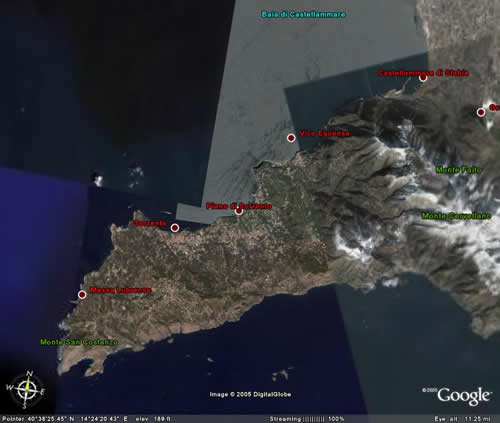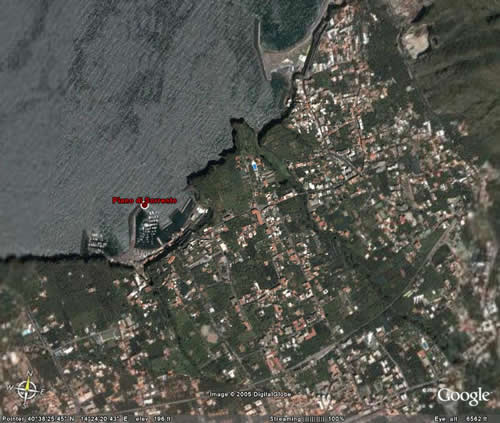Naples is the capital of Campania region and it situated at the foot of Mount Vesuvius. It is absolutely a fantastic city where You can find a lot of monuments and museums: “The Archeological Museum”, which holds the treasures from the nearby Roman ruins of Pompeii and Herculaneum; “The Dome”, where the earthly remains and the blood of San Gennaro, the patron saint of Naples are kept. The other churches of Naples are very important too. Noteworthy is the “Capodimonte Museum” that is one of the most important collections of paintings in the world and the “New Castle”, located next to the Municipio Square, with its early Renaissance triumphal arch overlooking the Ferry port. From Naples ferry port visitors can catch hydrofoils and auto ferries to the Islands of Capri, Ischia, Sicily and Sardinia.
https://www.napoli.com/english/
https://www.teatrosancarlo.it/english/home.html
Mt. Vesuvius is the best known volcano on earth; it dominates the Bay of
Naples with its characteristic cone. It is a typical example of a volcano in
a volcano made by an outer broken cone, Mt. Somma (1133 metres) with a
crateric belt most of which is destroyed. In it there is a smaller cone, the
Mt. Vesuvius (1281 metres), divided by lowering named Valle del Gigante
(Giants Valley), a part of the ancient caldron where in a later period,
perhaps during the 79 A.D. eruption, the Gran Cono (Great Cone) or Mt.
Vesuvius arose. The Valle del Gigante is still divided in Atrio del Cavallo
on the west and the Valle dell'Inferno on the east. The Somma's ancient
crater is well preserved as far as its entire northern part is concerned, in
fact in historic times it was less exposed to the volcano's devastating
violence, because it was well protected by the height of the internal face
that has prevented the downflow of lava on its slopes. The slopes, which
vary in their steepness, are furrowed by profound radial grooves produced
by the erosion of the meteoric waters. The whole section is then
characterized by dikes and fringes of dark volcanic rock. The old crater
edge is a stream of summits called cognoli. While the height of mount Somma
and its profile have remained the same for centuries, the height and the
profile of the mount Vesuvius have suffered considerable variation, because
of the following eruptions, with raisings and lowerings. Mt. Vesuvius is a
characteristic polygenic mixed volcano, meaning that it is constituted by
lava of different chemical composition (for example trachytes, tephrites,
leucitites) and formed either by casting of lava or pyroclastic deposits.
All the zones at the slopes of the mountain are formed by transported earth
of lava mud which goes down from the steep slopes in the rainy seasons
through deep and narrow grooves called channels or more commonly "lagni".
The high embankments are formed by piles of lavic scoriae, which
precipitated in incandescent state and spread towards the low slopes,
proving precious for the vegetation thanks to their fertile material, rich
in silicon and potassium. Proceeding along the rim of the crater, one can
observe the whole extent of the southern part of the volcano and, during
days with good visibility, it is possible to see the entire gulf of Naples,
from the Sorrento peninsula to Cape Miseno, Procida and Ischia. It is also
possible to note the large number of buildings which have been built on the
vulnerable flanks of the mountain. https://www.parks.it/parco.nazionale.vesuvio/Eindex.html
Pompeii is an archeological site that cannot be adequately described here. Buried under a thick layer of ashes by Mount Vesuvius during the eruption in 79 AD, Pompeii has been preserved over the centuries. It is a very important visit for those people who love in particular archeology.
https://www.pompeiisites.org/database/pompei/pompei2.nsf?OpenDatabase
https://www.pompeisepolta.com/
Amalfi Coast offers a place of rare and spectacular beauty, with small nice beaches interspaced with coastal summits with breathtaking views. There are many hiking paths in the area connecting the beaches and cliff side towns together.
https://www.amalfiscoast.com/index_en.htm
Capri still retains its beautiful appeal, which drew the Roman Emperors there – in particular Tiberius - during the I century AD. The island is famous for its grottoes, but it is also a good place for walking. The “Blue Grotto” is a cave bathed in blue iridescent light, which can be only be reached by boat.
https://www.capritourism.com/en/index.php Ischia with its beach resorts, thermal springs, therapeutic sands it is less famous than Capri but in no way less beautiful and it is well-known for its peace, stillness and relaxing atmosphere.
https://www.ischiamappe.it/mappa_en.asp
Paestum was a city founded in the VII century BC by Greeks and it is now an important archaeological sight where some of the best preserved monuments of the ancient Greek world are.
https://sights.seindal.dk/sight/86_Paestum-1.html
Caserta, the "royal" city, seat of the wonderful Reggia Vanvitelliana, is
very ancient and it maintains one of the most impressive medieval towns in
Italy. Known in ancient times as Galatea, its origin is Etruscan and it
already existed in the 9th century BC. Later it was occupied by the Samnites
and the Romans. The first Latin populations that occupied Caserta gave it
the name of "Saticula" and, later, of "Casa Hirta", whence the current name.
Starting in the Middle Ages, the city saw the alternation of various
dominations. First the Longobards and the Normans, who constituted the
Casertan State.
Then it was dominated by the Swabians and the Angevins, before going to the
Aragonians and the Bourbons. Precisely in this period the city went through
its maximum splendour, when Charles III of Bourbon and Amalia of the Saxons
chose it as their royal residence and commissioned architect Luigi
Vanvitelli to start the building works of the Reggia
Of course visiting Caserta has to start from the Reggia. This work is an
18th century art masterpiece and it was designed following the project of
Versailles, where Charles III had been educated. The visit of the Royal
Palace takes up a lot of time, but what your eyes will look onto is worth
any effort. The centre of the building is filled by the Scalone or large
staircase, where you can see the allegorical figures of Majesty, Virtue and
Merit. The inside of the Reggia is a constant follow through of
architectonic and painting masterpieces of neo-classic style, from the
antechambers to the royal apartments there are frescoes by Domenico Mondo,
canvases by Philipp Hackert and sculptural complexes by Vanvitelli himself.
A special mention is deserved by the immense outer gardens where, with the
extraordinary water games, you can admire interesting marble sculptures. As
well as the Reggia, Caserta has other attractions. The city preserves a
beautiful medieval town, "casertavecchia", where you can see the remains of
a castle dating back to the 11th century and a Cathedral built in the 12th
century. Nearby, in S. Maria Capua Vetere, there is a Roman amphitheatre,
one of the few monuments that has survived until today, dedicated to the
cult of God Mitra.
https://www.reggiadicaserta.org/
https://www.ambientece.arti.beniculturali.it/guida_reggia/Xenglish/index.htm
If you have few more days, why not to visit also other cities, villages, and places in Italy? Take a break from your work! Get a few days of vacation and relax...
Are you looking for any ideas? Here they are!
... and here you find information and ideas about places all over Italy (including further information about the above cities):
MILANO
A large industrial and commercial city, with a cultural heritage that is worth visiting:
VENICE
The most romantic and unforgettable lagoon of the world, full of monuments, bridges, calli, campielli, and gondolas.
FLORENCE
A jewel in the green hills of Tuscany...
ASSISI
A quiet town, where San Francesco was born and founded his order. This is a spiritual retreat full of history and monuments, in the heart of the green Umbria.
ROME
Have you never heard about Rome in Italy?!?!? Maybe you are not from our planet....
But also in this case, you will be glad to plan a visit to it!!! Don't be shy! Doesn't matter if your skin is green. Doesn't matter if your eyes are at the end of funny antennas! You will be always welcome in Rome!!!!
|

